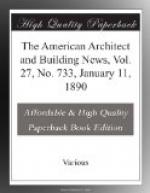The inquiry, then, has reached its limit; for, apart from the modes that have just been named, there are no others but earth-burial and entombment, and earth-burial, as we have seen, cannot be made sanitary under common conditions. Therefore, if the demands of affection and sanitation are both to be met, entombment is to do it, or it cannot be done.
Happily, better than any other method of disposing of the dead that has ever been devised, entombment has met the demand of affection. Never has any other mode so commended itself to men as this. There may have been at times a general adoption of cremation, and there may have been a general prevalence of earth-burial, but the one has not long satisfied the sorrowing survivors, and the other has owed its beginning and continuance to the apparent absence of alternative. Wherever the living have been able, and the dead have been dearly loved or highly esteemed, the tendency to entomb and not to bury has been constantly manifested.
To call attention to this tendency is enough to prove it, so easily accessible is the evidence and so familiar is its operation in the human heart. The most natural reference will be, first, to the mausoleum, the tomb of Mausolus, that was erected by his sorrowing Queen, Artemisia, at Halicarnassus, upon the AEgean’s eastern shore, and that became at once one of the few great wonders of the ancient world. This was intended to do honor to the loved and illustrious dead, and this it did as no grave or pyre could do. This was also intended to protect the lifeless form from ruthless robbery and reckless profanation, and it performed this task so well that for near two thousand years no human eye beheld the mortal part of Mausolus, and no human hand disturbed its rest. At a far earlier time, Abraham, the Father of the Faithful, while he illustrated this tendency to entomb the dead, also offered an influential example to all who would do him reverence, as, in the hour of his great sorrow, he sought the seclusion and the security of Machpelah’s cave for the last earthly resting-place of his beloved wife. There he buried Sarah; there he and his son and his son’s son and their wives were all laid to rest, and the place of their repose hath not been violated even at this distant day. To this constant tendency constant testimony is borne by the massive and magnificent tombs in which India abounds, the tombs and pyramids that make marvellous the land of the Nile, the tombs that stood thick upon the Appian Way, and that rose superb upon the Tiber’s shore, the modern use to which the Pantheon is put, the Pantheon at Paris and the Crypt of the Invalides, the Abbey of Westminster, matchless in memorials, the sepulchres within the hills that gird Jerusalem, and the sepulchre in which the Nazarene was gently laid when His agony was ended.
It remains to be considered whether entombment can be made sanitary. If it can be the problem is solved, for entombment has ever been the best that the living could do for their dead, and, with the added advantage of promoting, or ceasing to be prejudicial to, the public health entombment will be the choice of all whom cost or caprice does not deter.




